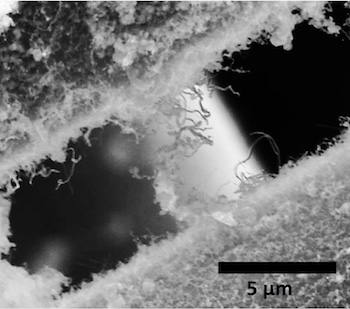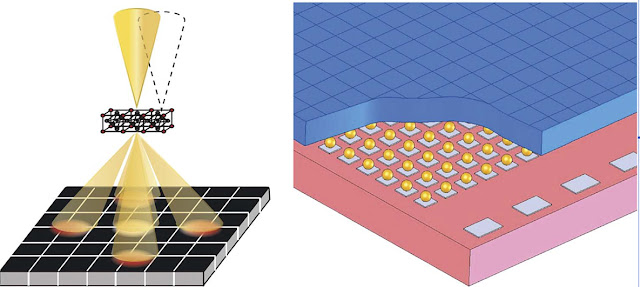Rocket engines of latest design have much vigor, and produces heat. Recently, NASA has made a joint effort in order to create some fibers for taking the heat of rockets.
The special fibers are manufactured with silicon carbide, which may be comparable to Velcro. They are able to resist the pressure, which is experienced by materials in many applications of aerospace. Such fibers give enough support to composite materials, which are often applied in the latest rocket engines with a capability of enduring high level of temperature. Ceramic materials, present in these rockets, make use of the fibers for toughening the system. However, at any time, brittleness or cracks may turn up, especially because of oxygen exposure.
Use of nanotubes along with fibers-
The researchers of Rice laboratory have implanted nanowires and tubes into fibers’ surface. The uncovered spots of these fibers have coiled design. They work almost as a hook to add value to Velcro. After making the experiment, the scientists have concluded that it leads to the development of powerful interlocking links with lots of knots of fibers. As a result, a composite has reduced level of cracking risk. Moreover, due to sealing, the chemical structure of fibers is not changed.
Amelia Hart, one of the students of Rice University, has stated that fuzzy fibers could be improved with the application of nanotubes (made of silicon carbide), which are interwoven with one another, while is placed inside composite. It also increases the resistance level and strength to endure intense heat.
A test on compression and friction confirmed about the force, which was essential for moving the nanotubes over one another. This force seemed to be quite higher than what is required for sliding the simple fibers or nanotubes. They could also pull through extreme compression, created with the help of nano-indenter. The indenters prevented breakdown for much extensive period.
The complete work has been explained in detail in one of the journals. It had been started, while Hart had met Meador, one of the researchers of NASA. Presently, Meador is a manager of nanotechnology program, while Hart was engaged in the study, related to carbon nanotubes development.
It had brought about a good partnership, which would increase the possibility of combining her thoughts with the engineer of NASA. A partial conversion of silicon carbides was accomplished. In fact, Hart had applied the skill for growing nanotubes to create fresh composite.
Tests on different fibers-
Hart along with other researchers blended the fiber in iron-based catalyst. After that, they applied a deposition of chemical vapor for inserting carbon nanotube system to a surface. It turned out to be the model of ultimate product. Then, these fibers had been heated under severe temperature.
It is considered by researchers that the fibers would modify heat and light resistant silicon carbide strand. The later one is able to stay consistent to almost 1,600 C. It gives the scientists a confidence on the success that they would get by integrating nanotubes, made of silicon carbide.
The special fibers are manufactured with silicon carbide, which may be comparable to Velcro. They are able to resist the pressure, which is experienced by materials in many applications of aerospace. Such fibers give enough support to composite materials, which are often applied in the latest rocket engines with a capability of enduring high level of temperature. Ceramic materials, present in these rockets, make use of the fibers for toughening the system. However, at any time, brittleness or cracks may turn up, especially because of oxygen exposure.
Use of nanotubes along with fibers-
The researchers of Rice laboratory have implanted nanowires and tubes into fibers’ surface. The uncovered spots of these fibers have coiled design. They work almost as a hook to add value to Velcro. After making the experiment, the scientists have concluded that it leads to the development of powerful interlocking links with lots of knots of fibers. As a result, a composite has reduced level of cracking risk. Moreover, due to sealing, the chemical structure of fibers is not changed.
Amelia Hart, one of the students of Rice University, has stated that fuzzy fibers could be improved with the application of nanotubes (made of silicon carbide), which are interwoven with one another, while is placed inside composite. It also increases the resistance level and strength to endure intense heat.
A test on compression and friction confirmed about the force, which was essential for moving the nanotubes over one another. This force seemed to be quite higher than what is required for sliding the simple fibers or nanotubes. They could also pull through extreme compression, created with the help of nano-indenter. The indenters prevented breakdown for much extensive period.
The complete work has been explained in detail in one of the journals. It had been started, while Hart had met Meador, one of the researchers of NASA. Presently, Meador is a manager of nanotechnology program, while Hart was engaged in the study, related to carbon nanotubes development.
It had brought about a good partnership, which would increase the possibility of combining her thoughts with the engineer of NASA. A partial conversion of silicon carbides was accomplished. In fact, Hart had applied the skill for growing nanotubes to create fresh composite.
Tests on different fibers-
Hart along with other researchers blended the fiber in iron-based catalyst. After that, they applied a deposition of chemical vapor for inserting carbon nanotube system to a surface. It turned out to be the model of ultimate product. Then, these fibers had been heated under severe temperature.
It is considered by researchers that the fibers would modify heat and light resistant silicon carbide strand. The later one is able to stay consistent to almost 1,600 C. It gives the scientists a confidence on the success that they would get by integrating nanotubes, made of silicon carbide.








